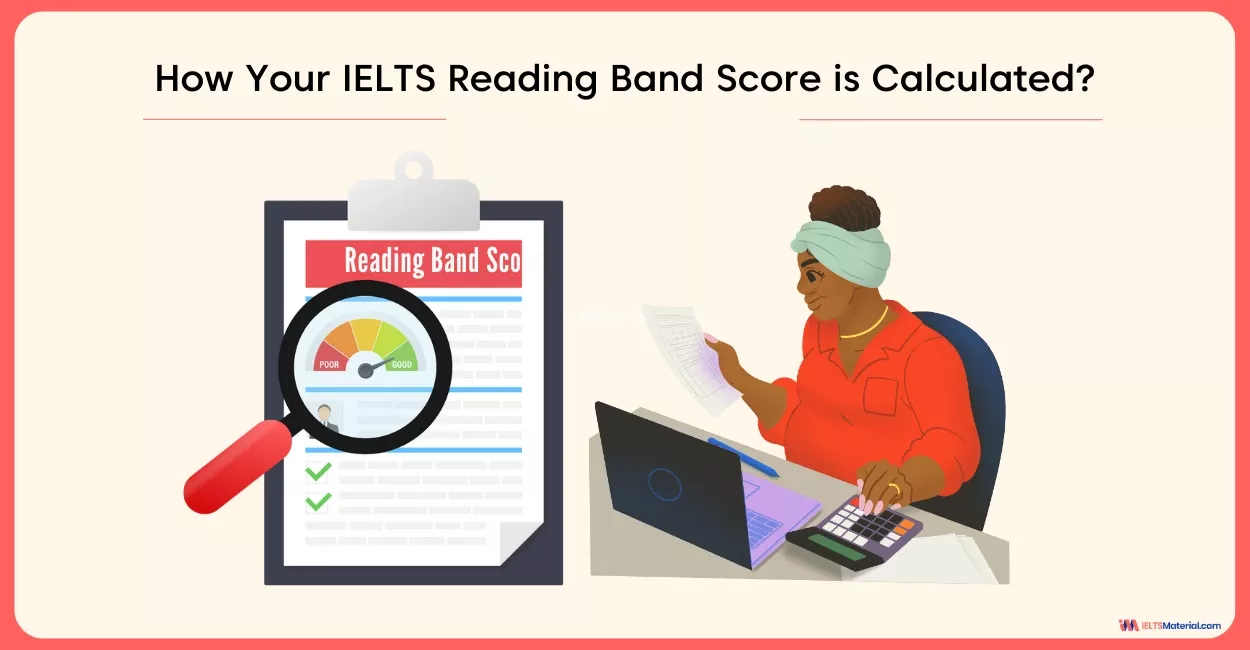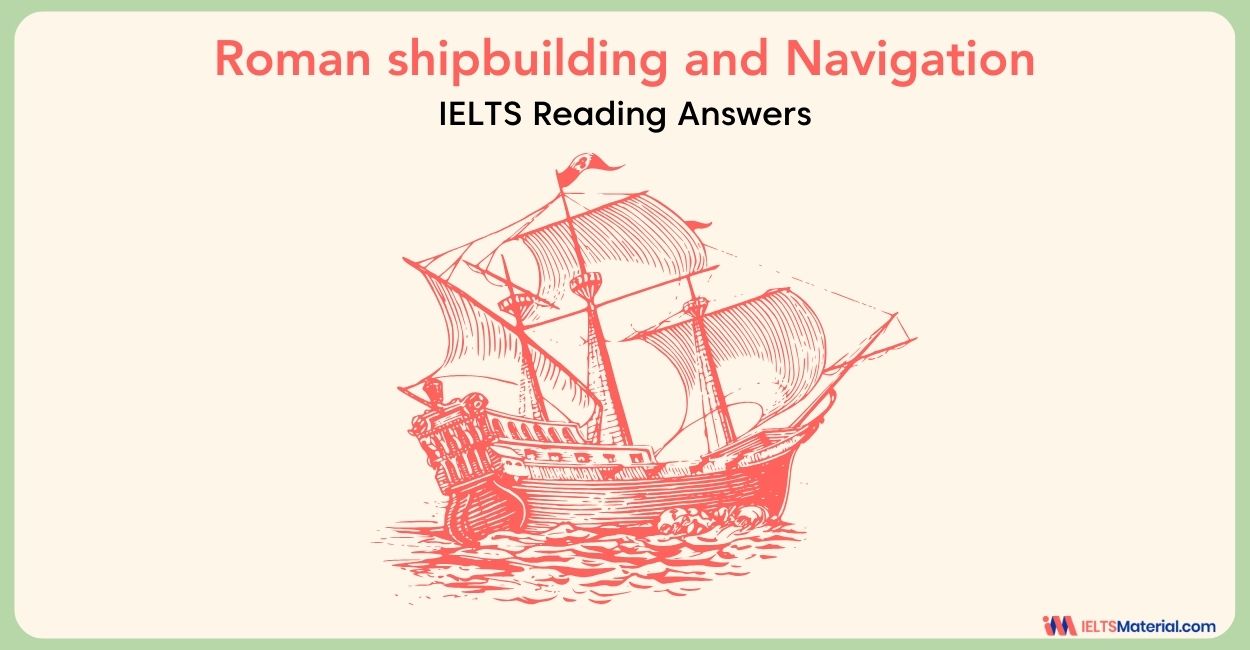Roman Shipbuilding and Navigation – IELTS Reading Answers
12 min read
Updated On
-
Copy link
This blog breaks down the Roman Shipbuilding and Navigation IELTS Reading passage with answer explanations, and strategies for every question type, and improve your accuracy and performance.
Table of Contents

Limited-Time Offer : Access a FREE 10-Day IELTS Study Plan!
Roman Shipbuilding and Navigation is a real IELTS Reading passage that can help boost your score with consistent practice. To excel in the IELTS Reading module, it's essential to master strategies for each question type. Set a 20-minute timer, attempt the passage, and explore more IELTS Reading practice tests to track your progress and improve your speed and accuracy.
The passage, Roman Shipbuilding and Navigation, is part of the IELTS Academic Reading that consists of 13 questions. The question types found in this passage are:
- True/False/Not Given IELTS Reading
- IELTS Reading Summary Completion
Before you take the test, learn some tips from this video to get that perfect IELTS reading score!
Roman Shipbuilding and Navigation IELTS Reading Passage
You should spend about 20 minutes on Questions 1-13, which are based on the reading passage 1 below.
Shipbuilding today is based on science and ships are built using computers and sophisticated tools. Shipbuilding in ancient Rome, however, was more of an art relying on estimation, inherited techniques and personal experience. The Romans were not traditionally sailors but mostly land- based people, who learned to build ships from the people that they conquered, namely the Greeks and the Egyptians.
There are a few surviving written documents that give descriptions and representations of ancient Roman ships, including the sails and rigging. Excavated vessels also provide some clues about ancient shipbuilding techniques. Studies of these have taught us that ancient Roman shipbuilders built the outer hull first, then proceeded with the frame and the rest of the ship. Planks used to build the outer hull were initially sewn together. Starting from the 6th century BCE, they were fixed using a method called mortise and tenon, whereby one plank locked into another without the need for stitching. Then, in the first centuries of the current era, Mediterranean shipbuilders shifted to another shipbuilding method, which is still in use today. It consisted of building the frame first and then proceeding with the hull and the other components of the ship. This method was more systematic and dramatically shortened ship construction times. The ancient Romans built large merchant ships and warships whose size and technology were unequalled until the 16th century CE.
Warships were built to be lightweight and very speedy. They had to be able to sail near the coast, which is why they had no ballast or excess load and were built with a long, narrow hull. They did not sink when damaged and often would lie crippled on the sea’s surface following naval battles. They had a bronze battering ram, which was used to pierce the timber hulls or break the oars of enemy vessels. Warships used both wind (sails) and human power (oarsmen) and were, therefore, very fast. Eventually, Rome’s navy became the largest and most powerful in the Mediterranean, and the Romans had control over what they therefore called Mare Nostrum meaning ‘our sea’.
There were many kinds of warships. The ‘trireme’ was the dominant warship from the 7th to 4th century BCE. It had rowers in the top, middle and lower levels and approximately 50 rowers in each bank. The rowers at the bottom had the most uncomfortable position as they were under the other rowers and were exposed to the water entering through the oar holes. It is worth noting that contrary to popular perception, rowers were not slaves but mostly Roman citizens enrolled in the military. The trireme was superseded by larger ships with even more rowers.
Merchant ships were built to transport lots of cargo over long distances and at a reasonable cost. They had a wider hull, double planking and a solid interior for added stability. Unlike warships, their V-shaped hull was deep underwater, meaning that they could not sail too close to the coast. They usually had two huge side rudders located off the stern and controlled by a small tiller bar connected to a system of cables. They had from one to three masts with large square sails and a small triangular sail at the bow. Just like warships, merchant ships used oarsmen, but coordinating the hundreds of rowers in both types of ships was not an easy task. In order to assist them, music would be played on an instrument, and oars would then keep time with this.
The cargo on merchant ships included raw materials (e.g. iron bars, copper, marble and granite), and agricultural products (e.g. grain from Egypt’s Nile valley). During the Empire, Rome was a huge city by ancient standards of about one million inhabitants. Goods from all over the world would come to the city through the port of Pozzuoli, situated west of the bay of Naples in Italy and through the gigantic port of Ostia, situated at the mouth of the Tiber River. Large merchant ships would approach the destination port and, just like today, be intercepted by a number of towboats that would drag them to the quay.
The time of travel along the many sailing routes could vary widely. Navigation in ancient Rome did not rely on sophisticated instruments such as compasses but on experience, local knowledge and observation of natural phenomena. In conditions of good visibility, seamen in the Mediterranean often had the mainland or islands in sight, which greatly facilitated navigation. They sailed by noting their position relative to a succession of recognisable landmarks. When weather conditions were not good or where land was no longer visible, Roman mariners estimated directions from the pole star or, with less accuracy, from the Sun at noon. They also estimated directions relative to the wind and swell. Overall, shipping in ancient Roman times resembled shipping today, with large vessels regularly crossing the seas and bringing supplies from their Empire.
Want to improve your IELTS Academic Reading score? Grab Our IELTS Reading Ebook Today!
Roman Shipbuilding and Navigation IELTS Reading Questions
Questions 1-5
1. The Romans’ shipbuilding skills were passed on to the Greeks and the Egyptians.
2. Skilled craftsmen were needed for the mortise and tenon method of fixing planks.
3. The later practice used by Mediterranean shipbuilders involved building the hull before the frame.
4. The Romans called the Mediterranean Sea Mare Nostrum because they dominated its use.
5. Most rowers on ships were people from the Roman army.
Questions 6 – 13
- Complete the summary below.
- Choose ONE WORD ONLY from the passage for each answer.
- Write your answers in boxes 6-13 on your answer sheet.
Warships and merchant ships
Warships were designed so that they were 6 ......................... and moved quickly. They often remained afloat after battles and were able to sail close to land as they lacked any additional weight. A battering ram made of 7 ......................... was included in the design for attacking and damaging the timber and oars of enemy ships. Warships, such as the ‘trireme’, had rowers on three different 8 ..........................
Unlike warships, merchant ships had a broad 9 ......................... that lay far below the surface of the sea. Merchant ships were steered through the water with the help of large rudders and a tiller bar. They had both square and 10 ......................... sails. On merchant ships and warships, 11 ......................... was used to ensure rowers moved their oars in and out of the water at the same time.
Quantities of agricultural goods such as 12 ......................... were transported by merchant ships to two main ports in Italy. The ships were pulled to the shore by 13 .......................... When the weather was clear and they could see islands or land, sailors used landmarks that they knew to help them navigate their route.
Want to boost your IELTS score? Enroll in our expert-led IELTS online classes today!
Roman Shipbuilding and Navigation Reading Answers With Location and Explanations
Let’s now review the answers to the questions from the passage in the reading section, Roman shipbuilding and Navigation IELTS Reading Answers, and assess your improvement for a high IELTS Reading band score.
1 Answer: False
Question Type: True/False/Not Given
Answer location: Paragraph 1, Lines 4-6
Answer explanation: “The Romans were not traditionally sailors but mostly land-based people, who learned to build ships from the people that they conquered, namely the Greeks and the Egyptians.” This suggests that Romans did not pass on the shipbuilding skills to Greeks and Egyptians, rather they learnt from them.
2 Answer: Not Given
Question Type: True/False/Not Given
Answer location: N/A
Answer explanation: There is no such reference of the need of skilled craftsmen for mortise and tenon method of fixing planks.
3 Answer: False
Question Type: True/False/Not Given
Answer location: Paragraph 2, Lines 9-12
Answer explanation: “Then in the first centuries of the current era, Mediterranean shipbuilders shifted to another shipbuilding method, still in use today, which consisted of building the frame first and then proceeding with the hull and the other components of the ship.” This suggests that frames were built first and then the hulls. Hence, it is a wrong statement.
4 Answer: True
Question Type: True/False/Not Given
Answer location: Paragraph 3, Lines 7-9
Answer explanation: “Eventually, Rome’s navy became the largest and most powerful in the Mediterranean, and the Romans had control over what they therefore called Mare Nostrum meaning ‘our sea’.” This sentence shows that Roman’s navy became the mightiest of all. Due to that, they had control over (dominated) the Mediterranean and called it Mare Nostrum.
5 Answer: True
Question Type: True/False/Not Given
Answer location: Paragraph 4, Lines 5-7
Answer explanation: “It is worth noting that contrary to popular perception, rowers were not slaves but mostly Roman citizens enrolled in the military.” This shows that most of the rowers employed in the ship were Romans who were part of the Roman military (from the Roman army).
6 Answer: lightweight
Question Type: Summary Completion
Answer location: Paragraph 3, Line 1
Answer explanation: “Warships were built to be lightweight and very speedy.” This line suggests that the warships were designed in such a way that they were lightweight and speedy (moved quickly).
7 Answer: bronze
Question Type: Summary Completion
Answer location: Paragraph 3, Lines 4-6
Answer explanation: “They had a bronze battering ram, which was used to pierce the timber hulls or break the oars of enemy vessels.” This suggests that the battering ram was made of bronze and it was used to attack and damage (‘pierce’ and ‘break’) the timber and oars of enemy ships (vessel).
8 Answer: levels
Question Type: Summary Completion
Answer location: Paragraph 4, Lines 1-3
Answer explanation: “The ‘trireme’ was the dominant warship from the 7th to 4th century BCE. It had rowers in the top, middle and lower levels, and approximately 50 rowers in each bank.” This suggests that warships had rowers on three different levels.
9 Answer: Hull
Question Type: Summary Completion
Answer location: Paragraph 5, Lines 3-4
Answer explanation: “Unlike warships, their V-shaped hull was deep underwater, meaning that they could not sail too close to the coast.” With reference to the merchant ships in the first sentence of the mentioned paragraph, the writer states that the hulls of the merchant ships were underwater (below the surface of the sea).
10 Answer: triangular
Question Type: Summary Completion
Answer location: Paragraph 5, Lines 6-7
Answer explanation: “They had from one to three masts with large square sails and a small triangular sail at the bow.” This shows that the masts of the merchant ships had both the square as well as the triangular sails.
11 Answer: music
Question Type: Summary Completion
Answer location: Paragraph 5, Lines 8-11
Answer explanation: “Just like warships, merchant ships used oarsmen, but coordinating the hundreds of rowers in both types of ship was not an easy task. In order to assist them, music would be played on an instrument, and oars would then keep time with this.” This shows that the music used to be played on the ships to synchronize the movement of oars at the same time for both merchant ships as well as warships.
12 Answer: grain
Question Type: Summary Completion
Answer location: Paragraph 6, Lines 1-7
Answer explanation: “The cargo on merchant ships included raw materials (e.g. iron bars, copper, marble and granite), and agricultural products (e.g. grain from Egypt’s Nile valley). During the Empire, Rome was a huge city by ancient standards of about one million inhabitants. Goods from all over the world would come to the city through the port of Pozzuoli situated west of the bay of Naples in Italy and through the gigantic port of Ostia situated at the mouth of the Tiber River.” This shows that agricultural goods like grains were transported by merchant ships to Pozzuoli and Ostia, two main ports in Italy.
13 Answer: towboats
Question Type: Summary Completion
Answer location: Paragraph 6, Lines 7-9
Answer explanation: “Large merchant ships would approach the destination port and, just like today, be intercepted by a number of towboats that would drag them to the quay.” This line informs us that tow boats were used to pull (drag) the ship towards the shore (quay).
Tips to Solve the Question Types in Roman Shipbuilding and Navigation IELTS Reading Answers
Let us check out some quick IELTS Exam Preparation Tips for Band Score of 8+ to answer the three types of questions in the Roman shipbuilding and Navigation IELTS Reading Answers:
True/False/Not Given
In the True/False/Not Given IELTS Reading questions are based on facts. Several factual statements will be provided to you, and it is up to you to determine whether or not they are accurate by reading the text. To answer this type of question, you can use the following strategies:
- Read the question and identify the keywords – Before reading the material, have a look at your list of True, False, and Not Given questions.
- Scan the passage for synonyms or paraphrased words of the keywords – When you have highlighted the keywords, swiftly read the text to look for paraphrases or synonyms.
- Match the highlighted words in the questions with their synonyms in the text – Once you find both sets of keywords, cross-check them to find the answer.
- Identify the answer – If the facts match, the answer is TRUE, and in case it doesn’t match, it is FALSE. If you are unable to find the answer or unsure of it, mark it NOT GIVEN.
Summary Completion:
IELTS Reading Summary Completion is a type of IELTS reading question that requires you to fill in a gap in a paragraph with a word or phrase from the passage. To answer this question type, you can use the following strategies to score your desired IELTS band score:
- Read the sentences carefully: This will give you an idea of the type of word or phrase that is missing.
- Scan the passage for the keywords: The keywords in the sentence can help you to identify the correct word or phrase.
- Read the sentence with the missing word or phrase: This will help you to see how the word or phrase fits into the sentence.
- Check your answer: Once you have filled in the gap, make sure that your answer makes sense in the context of the sentence.
Confused about IELTS prep? Join our exclusive IELTS webinar and clear all your doubts!
Practicing IELTS Reading passages like Roman Shipbuilding and Navigation is a great way to improve both accuracy and speed. To further enhance your performance, regularly take full-length IELTS Reading mock tests under timed conditions. These IELTS Reading Practice Tests simulate real exam scenarios and help you build the confidence needed to achieve a high band score on test day.
Check More IELTS Reading Answers
| Cod In Trouble Reading Answers | Why Pagodas Don’t Fall Down Answers |
| Anxiety Reading Answers | Australias Sporting Success Answers |
| Saving Language Reading Answers | A Book Review Reading Answers |
Also check :
- IELTS Reading Recent Actual Tests 2025
- 101 IELTS Academic Reading Past Test Papers with Answers PDF Download
- IELTS Exam Reading Answer Sheet (PDF)
- 20 Best IELTS Preparation Books for Self Study
- The Harbour View Hotel & Hardley Heath Car Boot Sale – IELTS Reading Answers
- The Beaver Valley Hotel & Using your New Electronix Printer – Reading Answers
- Causton Health Centre & Bentley Hospital Catering Service – Reading Answers
- Smoke Alarms in the Home & Sydney Opera House Tours – IELTS Reading Answers
Practice IELTS Reading based on question types

Start Preparing for IELTS: Get Your 10-Day Study Plan Today!
Recent Articles

Nehasri Ravishenbagam

Haniya Yashfeen

Haniya Yashfeen

Haniya Yashfeen




Post your Comments
1 Comment